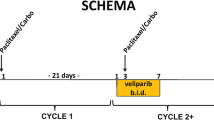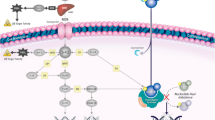Abstract
Purpose: PN401, an oral prodrug of uridine yields more bioavailable uridine than oral administration of uridine itself. PN401 may therefore be useful for permitting dose escalation of 5-fluorouracil (5-FU) with consequent improvements in antitumor efficacy. Experimental design: Female BALB/c mice (Colon 26 adenocarcinoma) were treated with 5-FU with PN401 to define the MTD, and pharmacokinetic analyses were done. A comparison of 5-FU/PN401 was made to 5-FU/eniluracil (EU) and 5-FU/LV. The best timing of the first dose of PN401 relative to 5-FU was evaluated by administering groups of mice PN401 beginning 2, 24, or 48 h after 5-FU dose. Results: The MTD of 5-FU was 100 mg/kg/week whereas the MTD of 5-FU + PN401 was 200 mg/kg/week. A complete response (CR) of 80% and partial response (PR) of 20% was observed with 5-FU (200 mg/kg) + PN401, CR of 40% and PR of 60% with 5-FU (175 mg/kg) + PN401, PR of 10% with 5-FU (150 mg/kg) + PN401 while no response with 5-FU (100 mg/kg) + PN401. Analysis of 5-FU pharmacokinetics displayed nonlinearity as a function of administered dose in mice. In the comparison study, the best response was achieved with PN401 when compared to EU and LV. Mice that did not receive PN401 died by day 12, while other groups were alive at day 31. The proportion of mice surviving was highest in the group which received PN401 at 2 h followed by 24 and 48 h. Conclusions: There is a threshold 5-FU dose after which the efficacy is dramatically improved—in mice bearing Colon 26 adenocarcinoma, that threshold is a dose of >150 mg/kg/week, and the increased efficacy correlates with about a fourfold increase in the AUC of 5-FU. PN401 used to rescue mice from the lethal toxicity of 5-FU entails that PN401 can be used as an antidote even when used up to 48 h after a 5-FU overdose.



Similar content being viewed by others
References
Allegra CJ, Grem JL (1997) Antimetabolites. In: DeVita VT Jr, Hellman S, Rosenberg SA (eds) Cancer: principles and practice of oncology, 5. Lippincott-Raven, Philadelphia, pp 432–451
Sobrero AF, Aschele C, Bertino JR (1997) Fluorouracil in colorectal cancer: a tale of two drugs—implications for biochemical modulation. J Clin Oncol 15:368–381
Grem JL (1996) 5-Fluoropyrimidines. In: Chabner BA, Longo DL (eds) Cancer chemotherapy and biotherapy: principles and practice. Lippincott-Raven, Philadelphia, pp 149–211
Martin DS, Stolfi RL, Sawyer RC et al (1982) High-dose 5 fluorouracil with delayed “uridine” rescue in mice. Cancer Res 42:3964–3970
Klubes P, Cerna I, Meldon MA (1982) Uridine rescue from the lethal toxicity of 5-fluorouracil in mice. Cancer Chemother Pharmacol 8:17–21
Martin DS, Stolfi RL, Sawyer RC et al (1989) Use of oral uridine as a substitute for parenteral uridine rescue of 5-fluorouracil therapy, with and without the uridine phosphorylase inhibitor 5-benzylacyclouridine. Cancer Chemother Pharmacol 24:9–14
Klubes P, Leyland-Jones B (1989) Enhancement of the antitumor activity of 5-fluorouracil by uridine rescue. Pharmacol Ther 41:289–302
Nord LD, Stolfi RL, Martin DS (1992) Biochemical modulation of 5-fluorouracil with leucovorin or delayed uridine rescue: correlation of antitumor activity with dosage and FUra incorporation into RNA. Pharmacology 43:2543–2549
Leyva A, van Groeningen CJ, Kraal I et al (1984) Phase I and pharmacokinetic studies of high-dose uridine intended for rescue from 5-fluorouracil toxicity. Cancer Res 44:5928–5933
van Groeningen CJ, Peters GJ, Nodal JC et al (1991) Clinical and pharmacologic study of orally administered uridine. J Natl Cancer Inst 83:437–441
Seiter K, Kemeny N, Martin D et al (1993) Uridine allows dose escalation of 5-fluorouracil when given with N-phosphonacetyl-L-aspartate, methotrexate, and leucovorin. Cancer 71:1875–1881
Schwartz GK, Christman K, Saltz L et al (1996) A phase I trial of a modified, intensive FAMTX regimen (high dose 5-fluorouracil + doxorubicin + high dose methotrexate + leucovorin) with oral uridine rescue. Cancer 78:1988–1995
Kelsen DP, Martin D, O’Neil J et al (1997) Phase I trial of PN401, an oral prodrug of uridine, to prevent toxicity from fluorouracil in patients with advanced cancer. J Clin Oncol 15:1511–1517
Codacci-Pisanelli G, Van der Wilt CL, Smid K, Noordhuis P, Voorn D, Pinedo HM, Peters GJ (2002) High-dose 5-fluorouracil with uridine-diphosphoglucose rescue increases thymidylate synthase inhibition but not 5-fluorouracil incorporation into RNA in murine tumors. Oncology 62(4):363–370
Ashour OM, Naguib FN, Panzica RP, Al Safarjalani ON, el Kouni MH (2000) Modulation of 5-fluorouracil host toxicity by 5-(benzyloxybenzyl)barbituric acid acyclonucleoside, a uridine phosphorylase inhibitor, and 2′,3′,5′-tri-O-acetyluridine, a prodrug of uridine. Biochem Pharmacol 60(3):427–431
Peters GJ, van Dijk J, van Groeningen CJ et al (1988) In vitro biochemical and in vivo biological studies of the uridine rescue of 5-fluorouracil. Br J Cancer 57:259–265
Inaba M, Mitsuhashi J, Ozawa S (1990) Kinetic analysis of 5-fluorouracil action against various cancer cells. Jpn J Cancer Res 81:1039–1044
Harris BE, Song R, Soong S et al (1990) Relationship between dihydropyrimidine dehydrogenase activity and plasma 5-fluorouracil levels with evidence for circadian variation of enzyme activity and plasma drug levels in cancer patients receiving 5-fluorouracil by protracted continuous infusion. Cancer Res 50:197–201
Hryniuk WM, Figueredo A, Goodyear M (1987) Applications of dose intensity to problems in chemotherapy of breast and colorectal cancer. Semin Oncol 14(Suppl 4):3–11
Hidalgo M, Villalona-Calero MA, Eckhardt SG, Drengler RL, Rodriguez G, Hammond LA, Diab SG, Weiss G, Garner AM, Campbell E, Davidson K, Louie A, O’Neil JD, von Borstel R, Von Hoff DD, Rowinsky EK (2000) Phase I and pharmacologic study of PN401 and fluorouracil in patients with advanced solid malignancies. J Clin Oncol 18(1):167–177
Larsson A, Carlsson G, Gustavsson B et al (1996) Different intravenous administration techniques for 5-fluorouracil: pharmacokinetics and pharmacodynamic effects. Acta Oncol 35:207–212
McDermott BJ, van der Berg HW, Murphy RF (1982) Nonlinear pharmacokinetics for the elimination of 5-fluorouracil after intravenous administration in cancer patients. Chemother Pharmacol 9:173–178
Baker S (2000) Pharmacology of fluorinated pyrimidines: eniluracil. Invest New Drugs 18(4):373–381
Ezzeldin H, Diasio R (2004) Dihydropyrimidine dehydrogenase deficiency, a pharmacogenetic syndrome associated with potentially life-threatening toxicity following 5-fluorouracil administration. Clin Colorectal Cancer 4:181–189
Acknowledgements
We thank James D. O’Neil, Ph.D. (of Wellstat) for the human pK data and the human PK table and Mahmoud el Kouni Ph.D. for the mouse 5-FU pharmacokinetic measurements.
Author information
Authors and Affiliations
Corresponding author
Rights and permissions
About this article
Cite this article
Saif, M.W., von Borstel, R. 5-Fluorouracil dose escalation enabled with PN401 (triacetyluridine): toxicity reduction and increased antitumor activity in mice. Cancer Chemother Pharmacol 58, 136–142 (2006). https://doi.org/10.1007/s00280-005-0129-x
Received:
Accepted:
Published:
Issue Date:
DOI: https://doi.org/10.1007/s00280-005-0129-x




